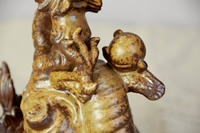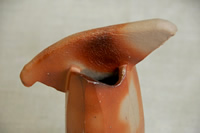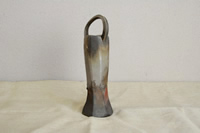
Porcelain production (To Sho En)
Porcelain ware productions are depends on a district and nature. Moreover, kilns in a same district also have different characteristics which are their own specialty. We would like to introduce some characteristics below.
1. Stoned clay
Stoned clay for Bizen porcelain ware is dug from the bottom of rice field. There used to be good quality reserve of stoned clay in Bizen city, but it has been exhausted. To Sho En has plenty storage from past decades at rice fields. It's not a careless storage Ethe remained clay get matured for years, and grown as much better porcelain clay to be firm pieces without cracks or broken. They stick this way to all works, even for a piece. This craftsmanship toward materials is greatly concerned to a next process and affects the best results.
The matured clay is separated into 3 layers and elutriated. (It is a process for separating lighter particles from heavier ones by stirring and precipitating in water.) By doing this in stages, they can use each clay for each purpose. The uniformed size of particles can be adjusted its softness to be appropriate for kneading. After a week to 10 days, it changes to be adhesiveness clay.
To Sho En basically use 2 types of clay for each work. "Gabutsu-no-tuchi" (雁E��の圁E is the rough one for potteries or flower vases, and "Migaki-no-tuchi"(磨き�E圁E is the smooth one for things that people directly touch their lips such as cups, and rice bowls, or ornaments.
This is the reason why people admire Bizen porcelain ware; even touching feels after firing are designed after their deep study, and all results are made from their endless efforts.


2. Forming
There are 2 types for Bizen forming, a pottery wheel and a pressing tool. Almost all pieces except for ornaments are created by well-experienced and skillful potter's wheels. Bizen porcelain ware is identified with its absence of glazing. (It's also considered as stoneware.) Therefore, very little forming actions with their fingers influenced by their emotions emerge as the surface result. We could say that clay see through their depression or anger all. It's like a sheer fight with swords. The adhesiveness clay after well-maturing insists sense of existence itself on a wheel, and potteries enhance the clay's allures at most for any small to huge piece like 45 centimeter without any pauses through forming.
They use very minute gypsum molds in the press-forming. Clay is inspired by the object's soul with its smoothness even in extreme intricate and minute mold, and become ornaments with spirits. Bizen owns approximately 50 molds which were made by ancient pottery artists. They created realistic ornaments, and sometimes humorous ones. Since the molding artists ceased, present potters has been using the old gypsum molds with great cares. Although they are great masterpieces, they are fated to be weeded out if they don't match the periods. The gypsum molds are treated as the precious treasures.


3. Firing
Bizen porcelain which uniquely has developed is identified with its simple and traditional methods such as absence of glazing, wood-firing. There mainly are three types.
For these three types of Bizen porcelain, they select the most appropriate clay, forming, placement arrangement, and carefully fire over a week. They aim the finest result from the very first step, clay maturing.
Bizen porcelain can be said that nature decides the result. It is very far from our modern systematic and industrialized production activities. Therefore it brings us the special and sole value. There is not the same one even from a same kiln. If you obtain a piece of such Bizen porcelain ware, you must realize that it is the only one for you, existing as a masterpiece which is never met anywhere else all over the world.


- "Goma"… Covered with ash on the surface, resulted as yellow Goma patterns. (Goma means seeds in Japanese.)
- "Hidasuki"…Resulted as orange lines by the ingredients included in straws.
- "Sangiri"…Resulted as mixed patterns after deoxidization of parts covered with ash.


"Goma"
Goma porcelain can be from a specific position from a kiln. It must be put near kiln's fire hole for the ash result. Potters need to know the best place where the temperature variation occurs with the most appropriate fire. If fire is too strong, cracks or damages arise on pieces so very few are successful as a result.


"Hidasuki"
It was originally one of the natural results from straws which were put between pieces to separate each other. It turns orange colored lines which enhance its bright impression. They use rice plants for the straws, and they should be thick and long since it's easy to wrap and make good patterns. However, it needs a process for bright and soft Hidasuki patterns. They remove all cores of straws in advance, and pound to soften, and then wrap pieces with the processed straws. Wrapping also needs a special technique. If they do not successfully wrap pieces, it can be loosed in a kiln and orange lines cannot be turned as designed.


"Sangiri"
Bizen porcelain ware is basically fired under the condition of oxidization (fired with a lot of air), but Sangiri is the result after intentional deoxidization. (Fired with less air.) Therefore, Sangiri makes very mixed results. They cannot easily control Sangiri patterns due to the difficulty of firing position in a kiln. Even if they use a special Sangiri kiln, they could not control blazing fire. Skillful potters arrange placement for each pieces regardless of the sizes, however, they never be able to know how the results turn out until a kiln is opened after firing process.
